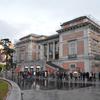More about Witches' Flight
- All
- Info
- Shop

Contributor
Francisco de Goya’s sinister painting Witches’ Flight references the Inquisition.
I think it’s safe to say that not many people would settle upon Francisco de Goya’s eerie Witches’ Flight as the perfect decoration for their home, yet the Duke and Duchess of Osuna would disagree. They purchased the painting in 1798 – along with five other works depicting witchcraft – to decorate their villa La Alameda, located close to Madrid. Since 1999, the painting resides in the Museo Nacional del Prado in Madrid.
The haunting scene of three creatures torturing a person in the middle of a pitch-black night seems like a vision from an especially terrifying nightmare. It is therefore no surprise that the painting has been described as “far more sinister and frightening” than the other pieces of the set acquired by the Duke and Duchess of Osuna. The three witches all wear tall hats that are called “corozas”. People had to wear these at their trial during the Inquisition. In Francisco de Goya’s painting, though, the hats are split in the middle which makes them appear more like bishop’s mitres. The flames on the hats suggest that the three characters have been condemned as sorcerers by the Inquisition. This makes the levitating figures victims of the Inquisition, while simultaneously depicting them as the ones who are inflicting violence. The people on the ground seem to want to escape the horrific spectacle happening above them. The person lying on the ground makes a gesture with their hand called the “figa sign” to ward off evil spirits.
Francisco de Goya’s Witches’ Flight also made an appearance in a movie. It has been featured in the 2013 psychological thriller “Trance” by Danny Boyle. Starring James McAvoy, Vincent Cassel, and Rosario Dawson, the movie revolves around Goya’s painting. Four men try to steal Witches’ Flight during an auction, but when the auctioneer can’t remember where he hid the painting, they ask a hypnotherapist for help.
Sources
- Boime, Albert. A Social History of Modern Art, Volume 2: Art in an Age of Bonapartism, 1800 – 1815. Chicago and London: The University of Chicago Press, 1990.
- Curbet, Joan. “''Hallelujah to your dying screams of torture': representations of ritual violence in English and Spanish Romanticism.” In European Gothic: A Spirited Exchange 1760-1960, edited by Avril Horner, 161-182. Manchester and New York: Manchester University Press, 2002.
- Hughes, Robert. Goya. New York: Alfred A. Knopf, 2006. https://books.google.cz/books?id=9wihUsJGg8sC&printsec=frontcover&hl=de….
- IMDb. “Trance.” Accessed July 18, 2022. https://www.imdb.com/title/tt1924429/.
- Museo del Prado. “Witches’ Flight.” Accessed July 17, 2022. https://www.museodelprado.es/en/the-collection/art-work/witches-flight/….
- Tal, Guy. “Demonic Possession in the Enlightenment Goya’s Flying Witches.“ Magic,. Ritual, and Witchcraft 11, no. 2 (Winter 2016): 176-207.
Featured Content
Here is what Wikipedia says about Witches' Flight
Witches' Flight (Spanish: Vuelo de Brujas, also known as Witches in Flight or Witches in the Air) is an oil-on-canvas painting completed in 1798 by the Spanish painter Francisco Goya. It was part of a series of six paintings related to witchcraft acquired by the Duke and Duchess of Osuna in 1798.
It has been described as "the most beautiful and powerful of Goya's Osuna witch paintings."
The painting was sold to the Duke and Duchess of Osuna on 27 June 1798, to decorate their villa La Alameda, on the outskirts of Madrid. It was then sold in 1896 at the public auction of the Osuna estate to Ramón Ibarra, and again in 1985 to Jaime Ortiz Patiño. Finally, it was acquired by the Prado in 1999, where it remains to this day.
At center point are three semi-nude witches wearing penitential coroza
bearing aloft a writhing nude figure, their mouths close to their victim, as if to devour him or suck his blood.
Below, two figures in peasants' garb recoil from the spectacle: one has thrown himself to the ground covering his ears, the other attempts to escape by covering himself with a blanket, making the fig hand gesture to ward off the evil eye. Finally, a donkey emerges on the right, seemingly oblivious to the rest of the scene.
The general scholarly consensus is that the painting represents a rationalist critique of superstition and ignorance, particularly in religious matters: the witches' corozas are not only emblematic of the violence of the Spanish Inquisition (the upward flames indicate that they have been condemned as unrepentant heretics and will be burned at the stake),
but are also reminiscent of episcopal mitres, bearing the characteristic double points. The accusations of religious tribunals are thus reflected back on themselves, whose actions are implicitly equated with superstition and ritualized sacrifice.
The bystanders can then be understood either as appalled but unable to do anything or willfully ignorant and unwilling to intervene.
The donkey, finally, is the traditional symbol of ignorance.
Check out the full Wikipedia article about Witches' Flight













